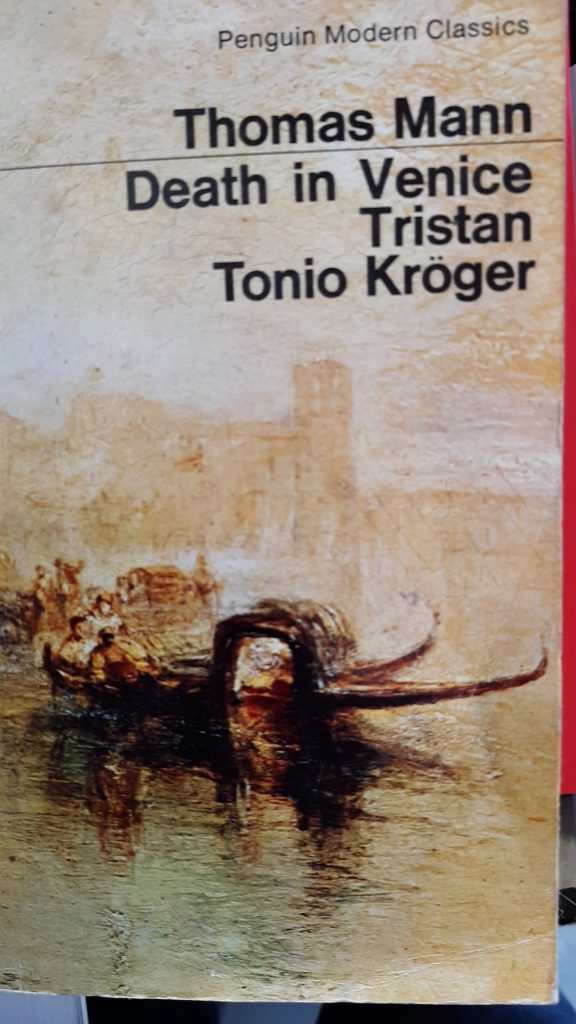
One evening, the boy directs a charming smile at him, looking, Aschenbach thinks, like Narcissus smiling at his own reflection. He watches him constantly and secretly follows him around Venice. Over the next days and weeks, Aschenbach's interest in the beautiful boy develops into an obsession. He happily returns to the hotel and thinks no more of leaving. When he reaches the railway station and discovers his trunk has been misplaced, he pretends to be angry, but is really overjoyed he decides to remain in Venice and wait for his lost luggage. On the morning of his planned departure, he sees Tadzio again, and a powerful feeling of regret sweeps over him. Soon the hot, humid weather begins to affect Aschenbach's health, and he decides to leave early and move to a cooler location. Later, after spying the boy and his family at a beach, Aschenbach overhears Tadzio, the boy's name, and conceives what he first interprets as an uplifting, artistic interest. His elder sisters, by contrast, are so severely dressed that they look like nuns. Aschenbach, startled, realizes that the boy is supremely beautiful, like a Greek sculpture.

Among them is an adolescent boy of about 14 in a sailor suit. Later, he has a disturbing encounter with an unlicensed gondolier-another red-haired, skull-faced foreigner-who repeats "I can row you well" when Aschenbach orders him to return to the wharf.Īschenbach checks into his hotel, where at dinner he sees an aristocratic Polish family at a nearby table. While shipbound and en route to the island, he sees an elderly man in company with a group of high-spirited youths, who has tried hard to create the illusion of his own youth with a wig, false teeth, make-up, and foppish attire.

Soon afterward, he resolves to take a holiday.Īfter a false start in traveling to Pula on the Austro-Hungarian coast (now in Croatia), Aschenbach realizes he was "meant" to go to Venice and takes a suite in the Grand Hôtel des Bains on the Lido island.
#Death in venice author full
He has a vision of a primordial swamp-wilderness, fertile, exotic and full of lurking danger. Aschenbach walks away, embarrassed but curiously stimulated. He is a man dedicated to his art, disciplined and ascetic to the point of severity, who was widowed at a young age.Īs the story opens, he is strolling outside a cemetery and sees a coarse-looking, red-haired foreigner who stares back at him belligerently. His perceptiveness as an interpreter of Western cultural heritage and his skill as a cosmopolitan teacher of democratic and humanistic values earned him recognition as a 'mirror of his age' and a 'citizen of the world'â ¦ Among Mann's many well-written works of short fiction, "Death in Venice" (1928), a novella based on Mann's impressions during his stay in Venice, is the most famousâ ¦ Typically for Mann, the novella deals with the problem of the unhappy, sick artist, Gustav von Aschenbach, who envies the healthy and 'normal' people of the bourgeois society" (Pribic, 262-3).The main character is Gustav von Aschenbach, a famous author in his early 50s who recently has been ennobled in honor of his artistic achievement (thus acquiring the aristocratic " von" in his name). "Thomas Mann is one of the greatest and most widely read authors of the 20th centuryâ ¦ An innovative stylist and synthesizer of the intellectual trends of his time, Mann exerted much influence on modern fiction not only in Germany but in Europe and in both Americas as well. First editions are rare, especially in the original dust jacket. Near fine in the rare original dust jacket with some light expert restoration to the crown of the spine. Translated from the German by Kenneth Burke.

Octavo, original cloth, patterned endpapers. inventory #33042.įirst edition in English preceding the British edition by three years of Mann's classic novel. Chase includes several additional short stories: 'Tristan', 'Tonio Kruger', 'Man and Dog: An Idyll', 'Hour of Hardship','Tobias Mindernickel', and 'The Child Prodigy'. This new translation of Nobel laureate Thomas Mann's work bu Jefferson S. Rich in mythical imagery, and exploring the themes of beauty and decay, passion and pestilence, DEATH IN VENICE is a disturbing, memorable work. Aschenbach finds himself completely, hopelessly obsessed with this ideal. The boy's name is Tadzio, and he comes to represent the sleek perfection of youth. Gustav von Aschenbach, a serious, dignified, lonely, and elderly writer, is enjoying a Venetian holiday when he notices the taut, lean figure of a Polish boy. FROM THE PUBLISHER - Thomas Mann's haunting novella DEATH IN VENICE tells the tragic and ironic story of a man who falls into foolish love, only to reap his own ruin.

Cover: Venetian Doorway,after 1900.Metrpolitan Museum of Art'. Translated From The German & With An Introduction By Jefferson S.


 0 kommentar(er)
0 kommentar(er)
